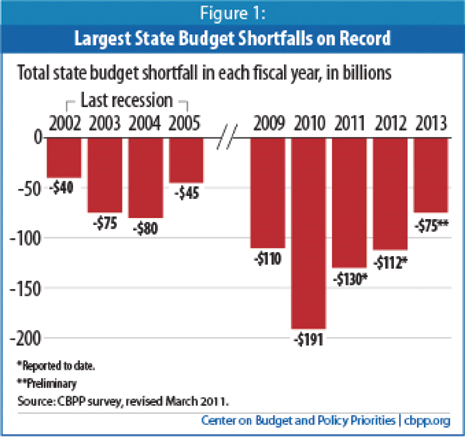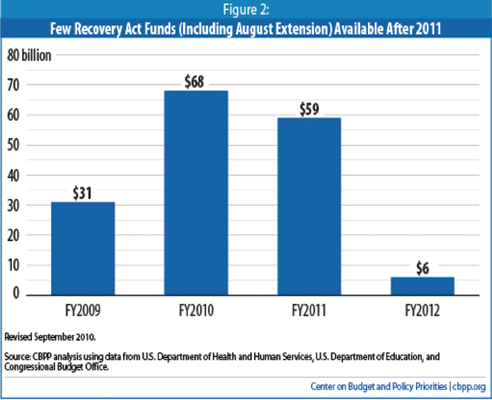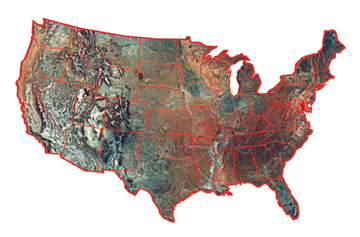The current status of the individual states that comprise the United States of America could be defined with the possible title for a television reality show—“The Sane, The Insane, and Those in Between.”
A cursory glance at the “state of the States” reveals an interesting pattern. The economic health of a state is determined by its relative independence from the federal government.
The Sane
A shining example is North Dakota, in which only 6.4 percent of the land is managed by public agencies. The federal government manages 4.3 percent while the state manages 2 percent.
In fact, North Dakota has far less federally managed land than other resource-rich states like Colorado, Utah, and Wyoming. It is this fact to which University of North Dakota economist David Flynn attributes the “stellar years.” The state’s unemployment has remained under 5 percent since 1987. In the first decade of the new millennium, the state’s per capita income rose from 38th to 17th in the nation—the largest advance of any state.
The privately owned land in the western part of the state is producing an oil boom, drawing workers from across the country. The oil windfall has created a $1 billion state budget surplus.
Trailing North Dakota in their own oil boom is Montana. According to Montana Governor, Brian Schweitzer:
We’re increasing in Montana by thousands of jobs in drilling in what’s called the Bakken (Shale Formation) in eastern Montana. It is the richest geologic structure in all of the United States. Recent estimates are that there’s about 25 billion barrels of recoverable oil in the Bakken in North Dakota and Montana. To put this in perspective, we import about 4 billion barrels a year. We use about 6 billion barrels a year. So this structure in North Dakota and Montana could be one of the keys to energy independence in the short term.
Indeed, it seems it is no coincidence that North Dakota and Montana are the only two states with budget surpluses at a time when others are slashing spending just to stay afloat.
Other states, with land availability, are following suit, however. New Mexico collected $9.5 million from oil and natural gas lease sales during the first quarter of 2011. Eastern Wyoming and Colorado are creating job opportunities with increased drilling in the Nobrara Shale Formation.
According to Kathleen Sgamma, Director of Government and Public Affairs for the Western Energy Alliance, the outlook could be even better. Most of the lands in production in the Bakken and Niobrara formations are privately owned. The bureaucratic red tape for drilling permits on federal and tribal lands is almost prohibitive. Sgamma made her point clear:
Because of certain regulatory efforts by this administration, particularly in the Department of the Interior and EPA, western producers were prevented from investing about $3.9 billion in 2010 and that translates roughly into 16,200 jobs.
Perhaps not wanting to be left behind, the Interior Secretary (and Colorado native), Ken Salazar, reported in March that there would be a 44 percent increase in permit approvals for oil and gas drilling on public lands in 2011.
The Insane
In the state of total insolvency is California. Unlike its more sane counterparts, California has swallowed the “green” pill of fiscal death. The most recent recycling effort was a plea for “revenue anticipation notes,” in which current notes (current debt) could only be re-paid by the revenue anticipation notes—essentially a never-ending supply of debt to repay debt in the ultimate recycling scam.
Needless to say, the efforts to raise $14 billion fell flat. California has now turned to the federal government to guarantee its debt against default, which means the taxpayers will have to be the ultimate buyers. So just what would we be purchasing?
The future of California may very well lie in the con-sequence of the November 2nd elections—the loss of the referendum to repeal Assembly Bill 32, the so-called Global Warming Solutions Act passed in 2006.
AB32 requires that the state economy be forced back to 1990 levels of “greenhouse gases” by 2020, a 30 percent drop, with an 80 percent drop by 2050. Many financial analysts agree that this legislation, with the unsustainable $500 billion public pension projection and the $28 billion 2011 budgetary shortfall, destines the state to bankruptcy.
According to George Gilder, founding fellow of the Discovery Institute, Assembly Bill 32 is a “parody of the supply side economics of creative destruction.” It seeks to usurp existing fuels with alternative energy sources that create new jobs and industries.
 This economic model sees new wealth emerge from dismantling the existing energy economy and replacing it with the “medieval system of windmills and solar collectors.” The core problem, according to Gilder, is that the destruction of the old energy system does nothing to enable a new one.
This economic model sees new wealth emerge from dismantling the existing energy economy and replacing it with the “medieval system of windmills and solar collectors.” The core problem, according to Gilder, is that the destruction of the old energy system does nothing to enable a new one.
The logic could be compared to razing an existing housing development and replacing it with fancy renewable tents. Of course, this economic decision is supported by the federal government via a system of subsidies for green jobs and environmentally (read that politically) oriented research and development within the state. And, many Californians believe they are the beacon to the rest of the country.
It is argued that California is the nation’s most important state. It has been dominant in the innovation, manufacturing, and enterprise that made the U.S. both economically and militarily powerful. Approximately two-thirds of the nation’s new technology originates in California or is financed by its venture capitalists.
Interestingly, the attorneys general of Alabama, Nebraska, Texas, and North Dakota have devised a legal strategy to block the effects of California’s strategy on the rest of the country. Wayne Stenehjem, attorney general of North Dakota, said:
We are going to test the limits of how much you can constrain interstate commerce in the name of climate change.
Regardless of viewpoint, one fact remains clear. California cannot collapse (economically or physically) without inflicting serious damage on the rest of the country.
Another story is unfolding in Texas, where it is difficult to determine the actual rate of recovery.
According to the Texas Comptroller of Public Ac-counts, two-thirds of the jobs shed by employers during Texas’ “shorter recession” have already been recovered as of January 2011. However, Texas’ unemployment rate remained relatively the same between September 2009 and January 2011.
In fact, one project which promised “shovel-ready” jobs with federal stimulus funds was the Trans-Texas Corridor.
 This massive roads project promised to connect Mexico, the U.S. and Canada along Interstate 35 and allow for an economic North American Union.
This massive roads project promised to connect Mexico, the U.S. and Canada along Interstate 35 and allow for an economic North American Union.
The project was scuttled in 2010 when Texans invoked the Coordination Process (see the December 2010 issue of Personal UPDATE for more details).
In March, however, a bill surfaced in the Texas Legislature that would resurrect the tolling mechanism that would fund the corridor projects—both I-35 and I-69.
Once again, Texas promises to be on the forefront of eminent domain abuses while Governor Rick Perry advocates for Texans’ property rights on his website. (The irony may become more apparent when we consider the Governor may consider running for President in 2012.)
The In Between
 As of March 2011, 44 states and the District of Columbia have projected budget shortfalls for fiscal year 2012 (which begins July 1, 2011 in most states) totaling $112 billion.
As of March 2011, 44 states and the District of Columbia have projected budget shortfalls for fiscal year 2012 (which begins July 1, 2011 in most states) totaling $112 billion.
On top of the larger shortfalls totaling $430 billion suffered between 2009 and 2011, many states will continue to struggle to find revenue needed to support critical public services for a number of years to come. According to the Center on Budget and Policy Priorities:
Over the past three years, states and localities have used a combination of reserve funds and federal stimulus funds, along with budget cuts and tax increases, to close these recession-induced deficits. While these deficits have caused severe problems, and states and localities are struggling to maintain needed services, this is a cyclical problem that ultimately will ease as the economy recovers. [emphasis mine]
The statement “as the economy recovers” appears to be the new panacea for the current status of the states with regards to budgets. However, the critical question is how long can each one survive until that uncertain goal is attained? While there were political rumblings of not accepting federal stimulus money in 2009, reports indicate a distribution of some portion of the allotment to every state.
During fiscal year 2011, states had access to approximately $59 billion in federal monies to assist in budget shortfalls of $130 billion. In fiscal year 2012, states are reporting budget shortfalls of $112 billion with only $6 billion in federal monies available. The federal stimulus money simply allowed a certain “status quo” in many states and delayed the inevitable analysis of cutting large budget items.
Essentially, federal assistance has lessened the ex-tent to which states are required to make “pro-cyclical” actions. State revenue streams cycle with the economic booms and busts, both locally and nationally.
Federal assistance in the form of subsidies in agricultural, education, commerce, energy, and housing among other sectors have assisted in propping up states’ budgets and allowed for excesses that can no longer be sustained in the current financial environment.
Moving Forward
In what is shaping up to be a year of discontent, both conservative and progressive sides are lining up their troops and their arguments.
The one commonality is the lack of accepting accountability.
One of the hottest issues causing widespread protests as seen in Wisconsin is the attack on public employee compensation and benefits as a major cause of budget shortfalls. Unions such as the SEIU (Service Employees International Union) are coordinating efforts to fight back. Papers such as the “State Budget Issue Brief” prepared by the Center for American Progress Action Fund does present an argument worthy of note:
Furthermore, states at the center of the debate over public-sector employees and budget deficits have smaller than average deficits. Wisconsin is projected to run a deficit of 12.8 percent of its budget in FY 2012 while the average for all states is 16.9 percent. Ohio, Indiana, and Iowa are projected to have shortfalls of 11 percent, 2 percent, and 3.5 percent, respectively, all below average.
However, all states are not in the same shape as those listed above. Universally, management of pension funds have created a mixed bag of results and the recipients will be affected—both public and private sector. An article in the McClatchy Newspapers reported:
Pensions are underfunded, in large measure because – like the investments held in 401(k) plans by American private-sector employees—they sunk along with the entire stock market.
No one seems to be questioning the practice of putting pension funds into the stock market as it is assumed the market will rebound. But, from an historical perspective, the stock market can be manipulated in either direction.
From a Biblical perspective, we could look at the condition of the hearts and minds of men (and women) before we look at budget protocols. One thing we do know is that we are in a series of birth pangs that have the attention of Believers. From individuals, to businesses, to local and state governments, to the federal government, to the global governments, each have put their faith in the upstream entity. This is the road paved to globalism.
We are seeing faith put in the establishment of world systems that have nothing to do with God’s plan for His people in the end of days. 2 Timothy 3 gives a view of mankind that is revealing itself exponentially in this economic crisis.
As we review the state of the States, we find a large “target-rich environment” in which to be salt and light to those who do not know who to blame or who to follow.
Shine your light!





